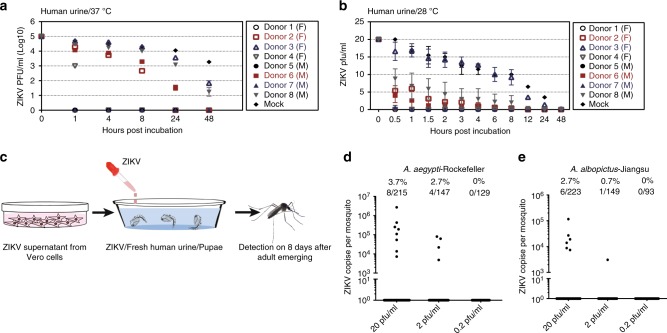Fig. 1.
Mosquitoes are permissive to Zika virus (ZIKV) infection during breeding. a, b ZIKV survivability in human urine. ZIKV was incubated with fresh human urine or phosphate-buffered saline (PBS) (Mock). The mixtures were then maintained at either 37 °C or 28 °C over a time course and subsequently subjected to a viral titration assay. The PRVABC59 strain was used for the incubation. The initial ZIKV titer was 1 × 105 or 20 pfu/ml. Data are presented as the mean ± S.E.M. a n = 3 biologically independent samples. b n = 2 biologically independent samples. The data were repeated by two independent experiments with the similar results. F: female; M: male. c–e Acquisition of ZIKV infection by Aedes mosquitoes breeding in infectious human urine. c Experimental schematic representation. Freshly emerging mosquito pupae were used for breeding in ZIKV urine. The urine from human Donor 3 (Fig. 1a) was used in these experiments. Both ZIKV prevalence and infectivity were determined in the A. aegypti Rockefeller strain (d) and the A. albopictus Jiangsu strain (e). The mosquitoes were breeding from human urine with serial ZIKV titration. The emerging adults were reared for an additional 8 days for ZIKV detection by TaqMan quantitative PCR (qPCR). The number of infected mosquitoes relative to the total number of mosquitoes is shown at the top of each column. One dot represents one mosquito. The percentages are represented as the ratios of mosquito infection. a–e Source data are provided in as Source Data file

